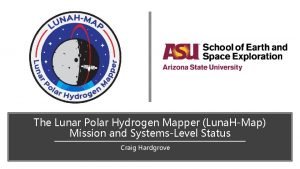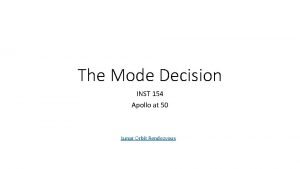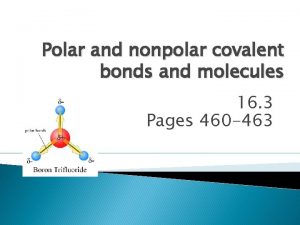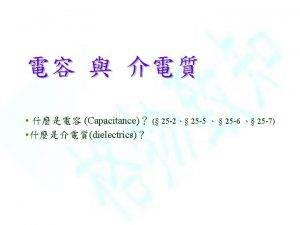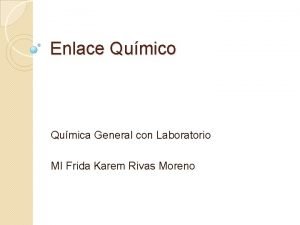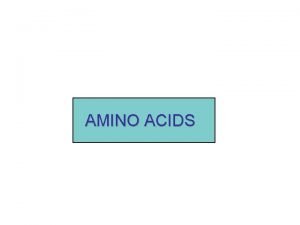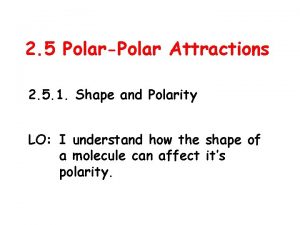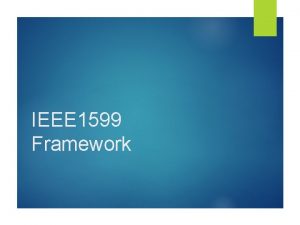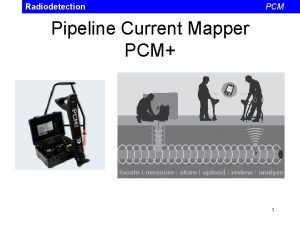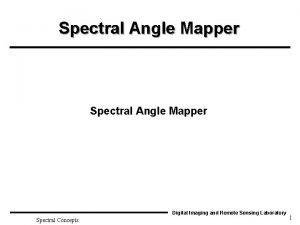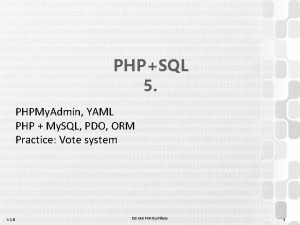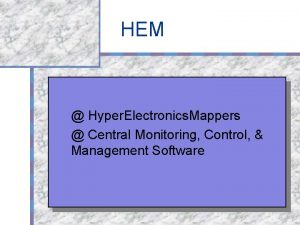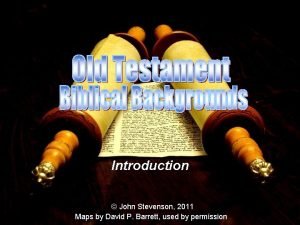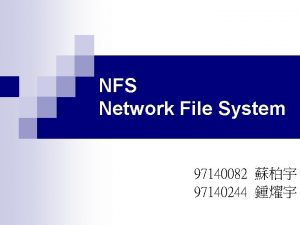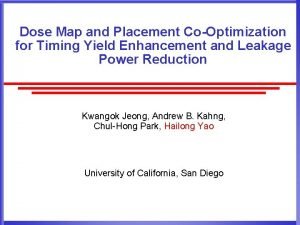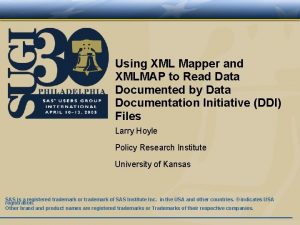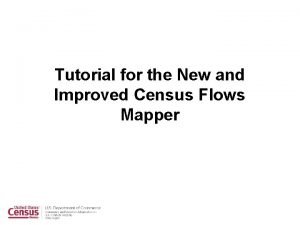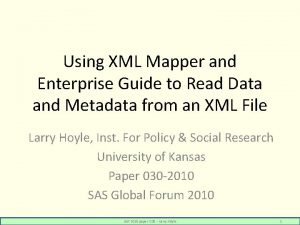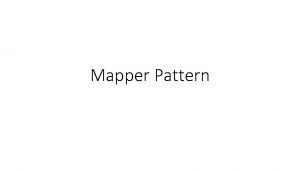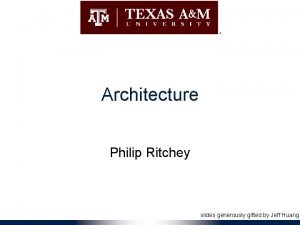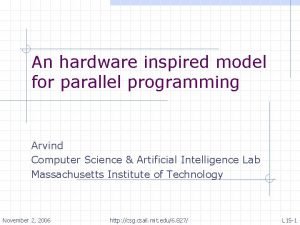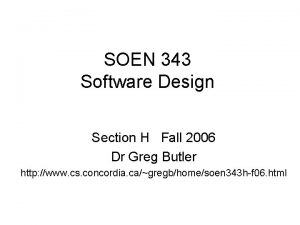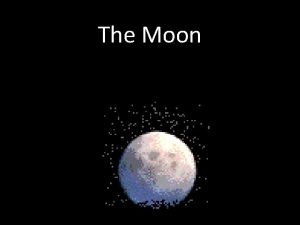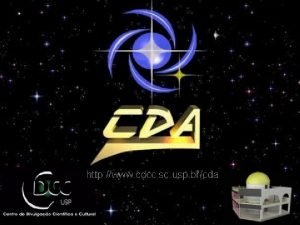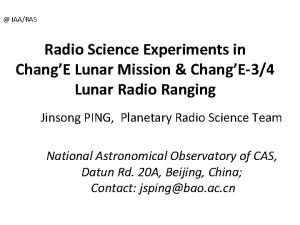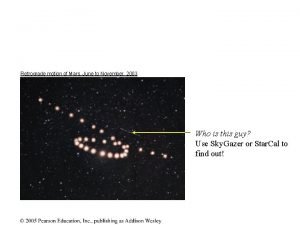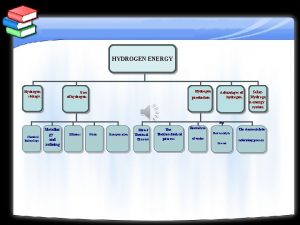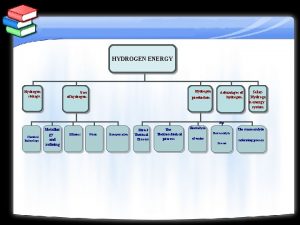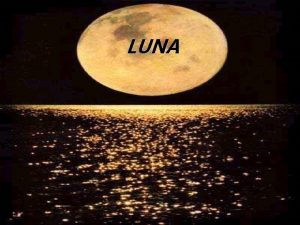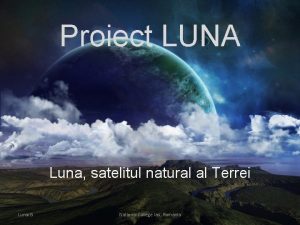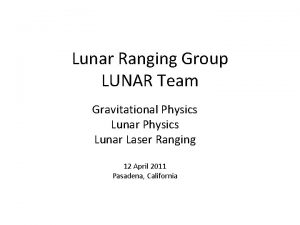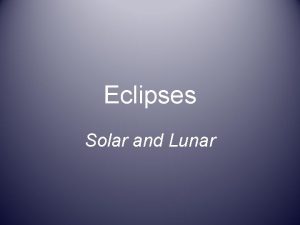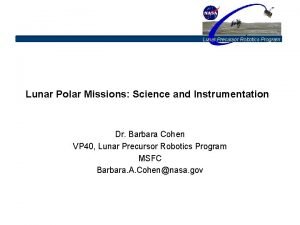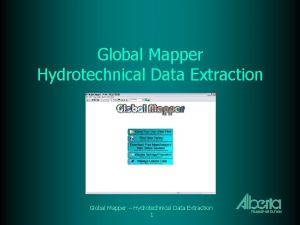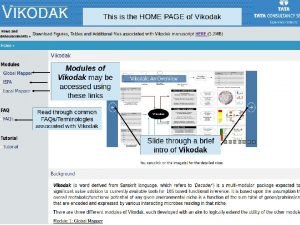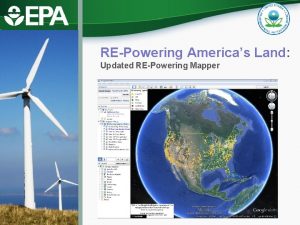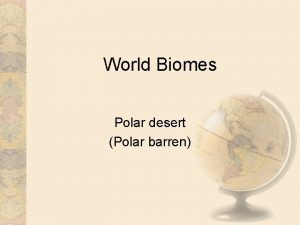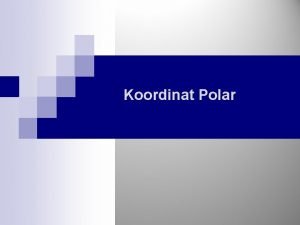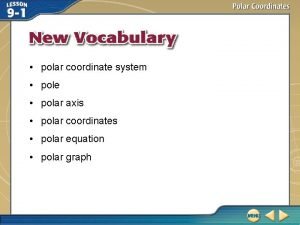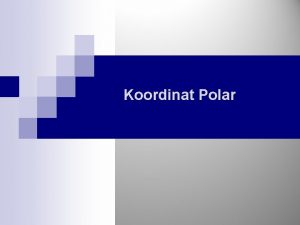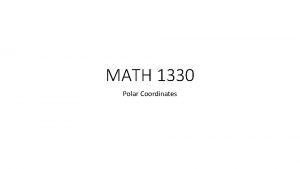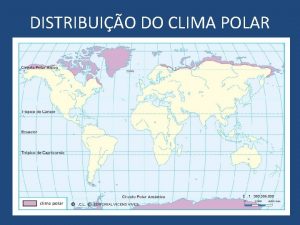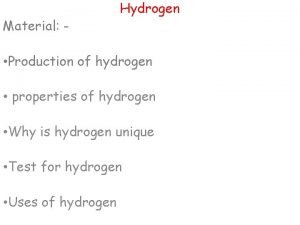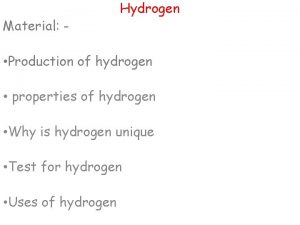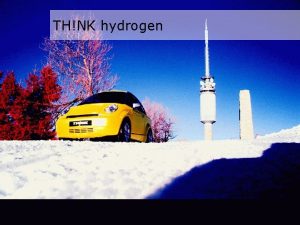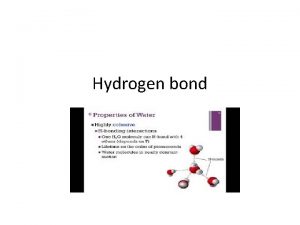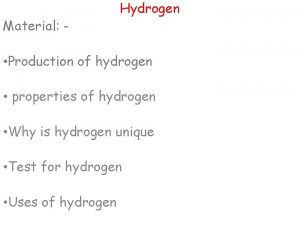The Lunar Polar Hydrogen Mapper Luna HMap Mission





























- Slides: 29

The Lunar Polar Hydrogen Mapper (Luna. H-Map) Mission and Systems-Level Status Craig Hardgrove

Luna. H-Map Mission Overview • NASA SMD SIMPLEx 2015 mission led by ASU • 6 U+ Cube. Sat form factor to launch on SLS EM-1 • Science Objective: Map hydrogen enrichments within PSRs at the lunar south pole • Tech Objectives: Demonstrate neutron spectroscopy, deep space operations & propulsion from a small sat Small Satellite Reliability Technical Interchange Meeting 2018 2

Polar Volatile Distributions from Neutron Spectroscopy 150 km 2 pixels *Feldman et al. , Science, 281, 1496, 1998 Small Satellite Reliability Technical Interchange Meeting 2018 • Neutron measurements are sensitive to bulk hydrogen distributions at 1 meter depth • Uncollimated neutron detector ‘footprints’ are approximately 1½ times orbital altitude • Lunar hydrogen abundances within PSRs broadly ranging from 200 ppm up to almost 40 wt% could be consistent with LPNS data depending on spatial distribution, extent of coverage, and burial depth [Lawrence et al 2006]. 3

Lunar Neutron Spectroscopy 35 km 2 pixels 15 km 2 pixels Pixon-based reconstruction of LPNS data (Elphic et al 2007) reveals high WEH abundances in Cabeus (near 1 wt%) and lower abundances in Shoemaker, Haworth, and Faustini (~0. 3 wt%) Analysis of LEND data (Sanin et al 2017) reveals higher WEH abundances (~0. 5 wt%) in south polar craters Shoemaker, Haworth, and Faustini Small Satellite Reliability Technical Interchange Meeting 2018 4

Lunar Neutron Spectroscopy 35 km 2 pixels 15 km 2 pixels Luna. H-Map will acquire similar neutron data from lower altitudes to constrain abundances at small spatial scales (~10 km x 10 km) Small Satellite Reliability Technical Interchange Meeting 2018 5

Luna. H-Map Predicted South Polar Volatile Mapping C H Sh S Simulations of maps made from 15 x 3150 km science orbit. Basemap combines LEND high H regions (Sanin et al. , 2017) and the Shackleton enrichment from pixon-reconstructed LPNS data (Elphic et al, 2007) to illustrate the type of map Luna. H-Map will be able to create. Small Satellite Reliability Technical Interchange Meeting 2018 6

Luna. H-Map Science and Technology Mission Objectives 1)Evaluate uniformity of hydrogen across the lunar south pole • Map hydrogen abundance of no less than 0. 6% WEH (600 ppm) +/- 120 ppm • Map hydrogen abundances at spatial scale of less than or equal to 15 km 2 2)Demonstrate neutron spectroscopy from a 6 U Cube. Sat • Acquire in-flight data from Mini-NS instrument 3)Demonstrate emerging capabilities of small spacecraft relevant to planetary science missions • Maneuver using a low-thrust ion propulsion system into polar lunar orbit • Demonstrate deep space communications and operations with an interplanetary Cube. Sat • Demonstrate e. Hawk+ solar array design in flight • Demonstrate autonomous performance of Cube. Sat command data handling subsystem (fault recovery, scheduled propulsive maneuvers, fine pointing, etc. ) 7

The ASU Luna. H-Map Team

Luna. H-Map Partners C&DH, EPS, and ADCS Mission Design & Navigation Ames Research Center Mission Design, Integration & Test Mini-NS Instrument Marshall Spaceflight Center SLS Secondary Payload Office Propulsion Kennedy Space Center Launch Vehicle Integration Solar Arrays Communications, DSN 9


Who We Are / How We Are Managed a. b. c. d. This project is at the crossroads of cubesat and traditional gated engineering development NASA Science Mission Directorate ASU is the prime, student work is integrated into a professional structure Many subcontractors: JPL, BCT, Busek, RMD, MMA, Kinet. X, NASA Ames, Marshall and Kennedy Earth and Moon by OSIRIS-REx 10 -22017

Luna. H-Map Mission Summary a. b. c. d. e. In development since late 2015 S/C delivery in April 2019 Launch on SLS EM-1 in late 2019 Deploy – Cruise – Transition to lunar orbit in mid -2020 60 day science phase Earth and Moon by OSIRIS-REx 10 -22017

Trajectory Design 1 2 3 Period 4. 76 hour Aposelene Altitude 3150 km Periselene Altitude RAAN dependent 15 -25 km Inclination 90° Argument of Periselene 273. 5° Genova, A. L. and Dunham, D. W. (2017) 27 th AAS/AIAA Space Flight Mechanics Meeting 17 -456. Small Satellite Reliability Technical Interchange Meeting 2017 13

Road to Launch • Critical Design Review – Completed June 29, 2017 • Phase 2 Safety Review – August 8, 2017 • Enter Assembly, Integration, and Test – Q 4 2017 • AI&T Review/Workshop with review board • Launch – SLS EM-1, NET Dec 2019 Luna. H-Map Program Milestones to Date IAA 11 December 2015 Δ-IAA REQUIRED Δ-IAA 24 February 2016 PASSED with RFAs SRR 8 April 2016 PASSED with RFAs I-PDR 9 June 2016 PASSED with RFAs P 1 SR 21 June 2016 PASSED M-PDR 25 July 2016 PASSED with RFAs CDR 29 June 2017 COMPLETED Small Satellite Reliability Technical Interchange Meeting 2017 14

Luna. H-Map Flight System Single Axis Solar Array Drive 1: 1 3 D Printed Model of Luna. H-Map Flight System Mini-NS Instrument LGA XB 1 -50 / Solar Array Primary Coarse Star Tracker Hold Down Sun Sensor Arms LGA Separation BIT-3 Thruster Connector Coarse Sun Sensor Small Satellite Reliability Technical Interchange Meeting 2017 15

Propulsion (BIT-3) • Busek BIT-3 ion thruster • Iodine propellant • 10° gimbal for momentum management Small Satellite Reliability Technical Interchange Meeting 2017 16

Miniature Neutron Spectrometer CLYC Module Detector 2 x 4 array of CLYC (elpasolite scintillator, Cs 2 Li. YCl 6: Ce) crystals, each crystal 4 cm x 6. 3 cm x 2 cm Dimension s 25 cm x 10 cm x 8 cm Mass 3. 3 kg Power 10 W (min), 22 W (max) Data Counts binned Acquisition every 1 sec Instrument Housing and Electronics ISSC 2018 – May 7 Caltech Pasadena, CA 17

Mini-NS EDU Test results from single EDU module exposed to Na-22 and Am. Be ISSC 2018 – May 7 Caltech Pasadena, CA 18

Flatsat

Prototype Components 3 D printed full

Engineering Models

Qualification • FM components are tested to GEVS prior to delivery • S/C at proto-qual vibe and TVAC levels • Mini-NS calibration at Los Alamos Neutron Free In-Air Facility (LPNS and Dawn GRa. ND instrument calibration) Test • • Component functional testing integrated in S/C level functional testing – operational modes, day-in-the-life GDS testing with Flat sat and flight components, S/C Flat sat development: EM (C&DH, EPS, Expansion Board, Solar Arrays, Iris radio), Emulators (BIT-3 propulsion, Iris radio, Mini-NS, SATA), EDU (Mini. NS) Small Satellite Reliability Technical Interchange Meeting 2018 22

Lessons Learned So Far … FLUID DESIGN PROCESS REQUIRED • Examples of fluid design so far: • As a result of the safety review with launch vehicle (SLS), a late change was identified that required extra level of fault tolerance in separation switches. A third switch violated the allowable switch force pushing on the pusher plate. We identified a new switch lever that imparts a much lower force, and re-designed the bracket to permit the installation of three switches. All of this re-design was done within the same volume as the old design and without changing any other component on the spacecraft at a net zero mass change. • EM solar array sticking in deployment tests. Resolved with a change in procedure and inspection. • Dispenser Interference. Hole interference with the dispenser ICD. Resolved through a slight design change. • The Mini-NS design was coming in over weight. We formed a tiger team to assess the mass of all components and reduced the overall mass to within an acceptable level for the spacecraft • BCT identified noise on sun sensor readout lines. Resolved by not polling the magnetometer. • The EPS and XEPS board brackets have an interference with traces on the EPS and XEPS boards. The resolution is to re-work the brackets to avoid the traces. • We have an unavoidable interference between the screws that mount the Solar Array and the BIT-3 volume. We have gotten approval from Busek to violate the volume envelope in the area of the screws. • Perform GDS trade study early on in coordination with the C&DH vendor and FSW team Small Satellite Reliability Technical Interchange Meeting 2017 23

Lessons Learned So Far … • Documentation - inconsistencies in documentation. Perhaps this is partly due to more NRE from the subs on lunar missions vs. LEO missions? How do the actual class-D cubesats handle this (e. g. TROPICS, Min. XSS? ). Technical Project Management is Required by CE, PSE, ME/TE/EE team, PI • Approach to Flight Hardware - We are aiming for a middle road between traditional academic Cube. Sats that may only have FMs for key subsystems which they use for development, testing, and flight and larger projects that have complete EMs and only use FMs for final integration, test, and flight. We are taking steps to check EMs against software emulators and development units in parallel with development using the FMs (at BCT). No Flight Spares Approach • Calibration with Integrated System - Unlike larger spacecraft/instruments, we have the option to perform our instrument calibration with many of the spacecraft systems in place. This reduces the risk that the spacecraft EPS/CDH have unknown interferences with the instrument that we only discover in flight. Unique Risk Reduction and Science Opportunities Small Satellite Reliability Technical Interchange Meeting 2018 24

What Worked / Is Working ○ Gated reviews work - SRR, IAA, PDR, CDR, SLS safety review process ■ Design maturation at slower rate, punt on certain tasks at reviews, punt on ○ ○ ○ ○ some (not all) subsystem reviews, close RFAs later at next review or memo/presentation to review board Partnerships with NASA centers and other institutions ■ Rely on expertise in reviews ■ Shared facilities and equipment Relying on subs in design and implementation Modifying LEO hardware for deep space, tolerant to resets, i. e. radiation (somewhat TBD) Early emulator/EM and 3 D model development Early thermal design and analysis Early wire harness routing on physical model Collaborative engineering using cloud based resources ■ Necessary to collaborate often with remote team members and subs Small Satellite Reliability Technical Interchange Meeting 2018

What Was / Is Harder ○ Low TRL components ECRs ■ Process changed to lower risk ■ Tiger team to deal with a mass reduction due to parallel instrument and spacecraft development ■ Attempt to extend performance beyond design and destroyed hardware ■ Schedule slips on almost all of our vendors ○ ICD ■ Resolved with early 3 D modelling and actual 3 D printing of flight design ■ e. ICDs tend to lag hardware, requires constant communication ■ True and complete documentation from vendors and internally ○ SLS ■ Schedule slips, requirements definition, interface waivers (just don’t) ○ Failure modes and recovery ○ DSN time - Early on-orbit checkout - Early burn needed because we are a secondary ○ “Design – Build – Test/Fly time X” is necessary but hard (budgets, EMs) Small Satellite Reliability Technical Interchange Meeting 2018

What Is Next a. b. c. d. e. f. Flight integration Calibration at the system level Environmental - full system - test as we fly Storage? Launch Operations Small Satellite Reliability Technical Interchange Meeting 2018

Backup Small Satellite Reliability Technical Interchange Meeting 2017 28

PI: Craig Hardgrove, ASU PM: Teri Crain, ASU Mission Manager: Rick Turner PS: Bobby Fogel PE: Gordon Johnston Luna. H-Map Cube. Sat Mission Manager’s Assessment Technical JUL AUG G G Cost Schedule JUL AUG G G JUL AUG Y-G G Solar System Exploration Programmatic JUL AUG G G Overall JUL AUG Y-G G Technical: No significant issues Cost: No significant issues Schedule: No significant issues Programmatic: No significant issues G On plan, adequate margin Y Problems, working to resolve within planned margin R Problems, not enough margin to recover 29
 Lunar polar hydrogen mapper
Lunar polar hydrogen mapper Inst154
Inst154 Polar and non polar
Polar and non polar Polar and non polar dielectrics
Polar and non polar dielectrics Enlace metalico
Enlace metalico Polar y no polar
Polar y no polar Why is lysine basic
Why is lysine basic Polar polar attractions
Polar polar attractions Ieee 1599
Ieee 1599 Pipeline current mapper
Pipeline current mapper Spectral angle mapper
Spectral angle mapper Django orm
Django orm Transaction script pattern
Transaction script pattern Hyper electronics mappers
Hyper electronics mappers Bible mapper
Bible mapper Port mapper failure - timed out
Port mapper failure - timed out Dose mapper
Dose mapper Sas xml mapper
Sas xml mapper Census flows mapper
Census flows mapper Mysas2
Mysas2 Mapper design pattern
Mapper design pattern Active record vs data mapper
Active record vs data mapper Gcd mapper
Gcd mapper Imagic mapper
Imagic mapper Active record vs data mapper
Active record vs data mapper Moon phases diagram
Moon phases diagram Eclipse penumbral
Eclipse penumbral Lunar
Lunar Partial lunar eclipse
Partial lunar eclipse Lunar legend festival riddles
Lunar legend festival riddles
